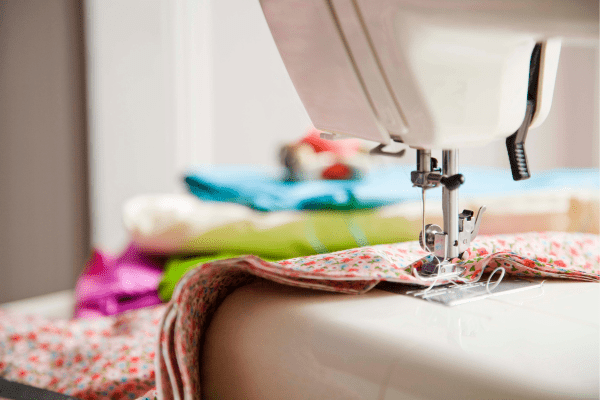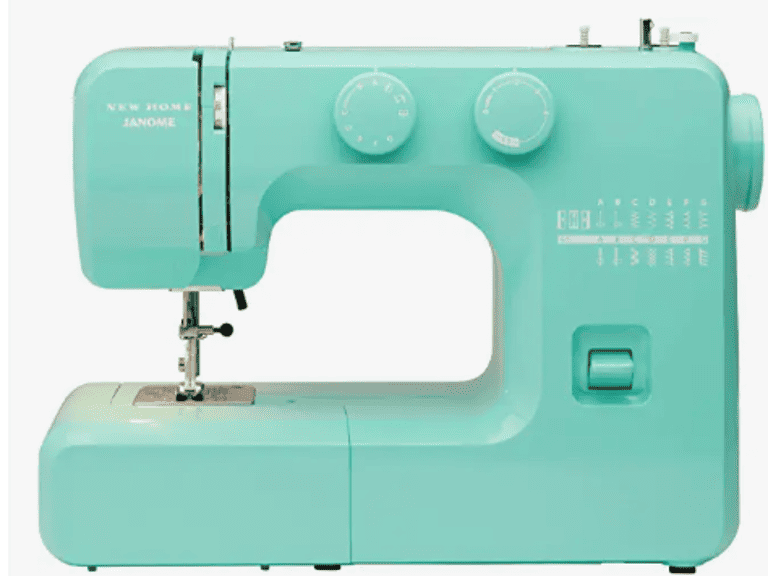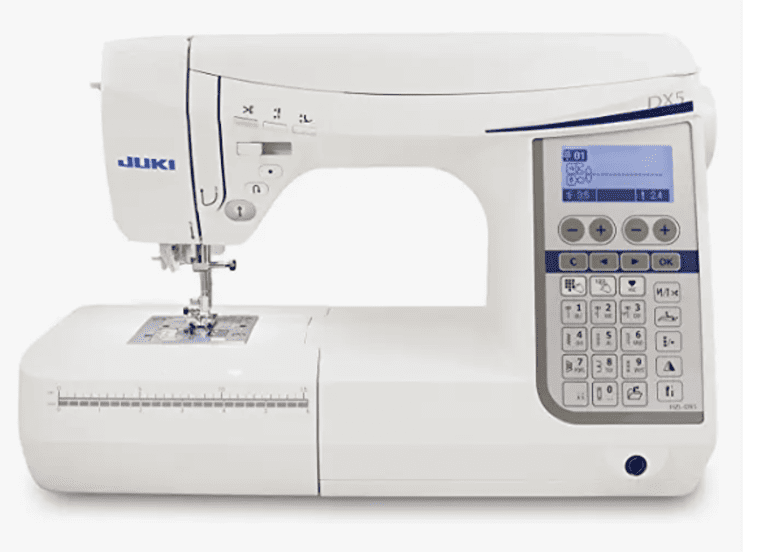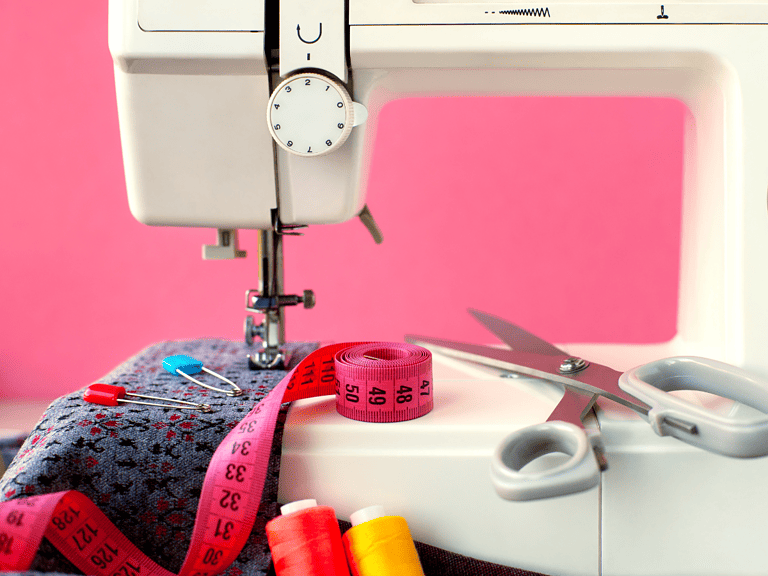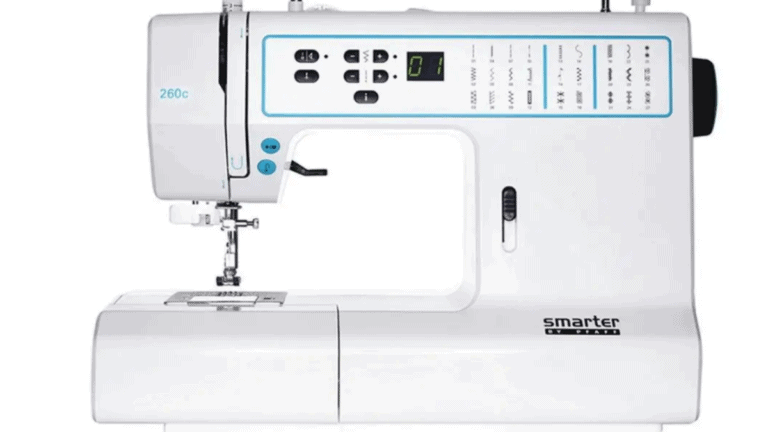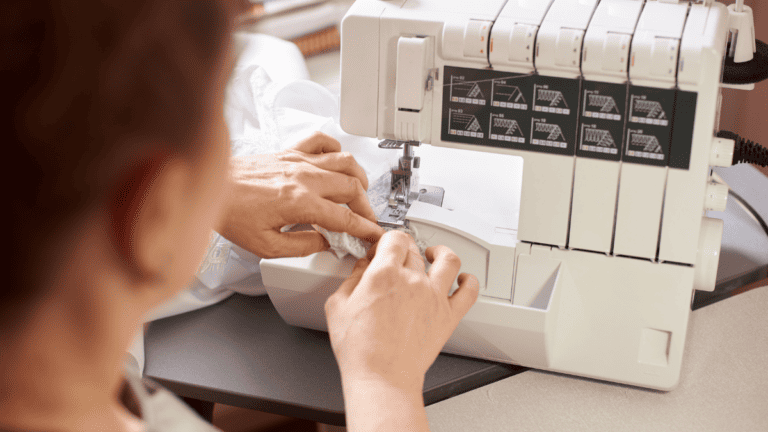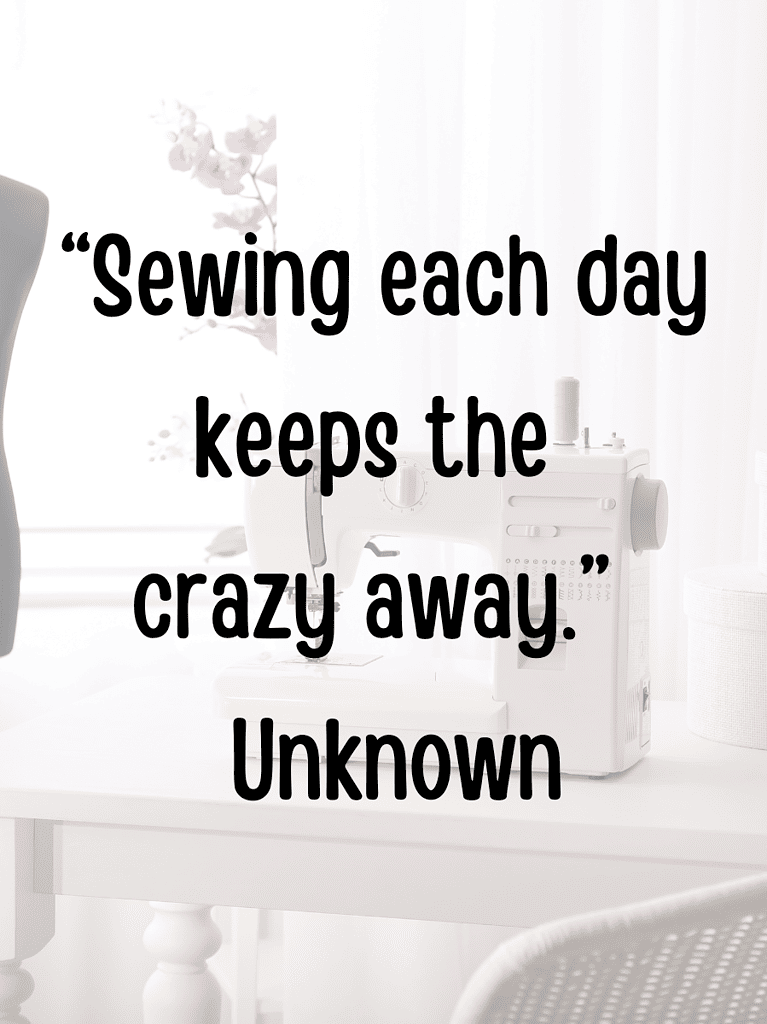Sew Like a Pro: know Different Types of Stitches sewing
Warning: Undefined array key "titleWrapper" in /home/nanahxof/public_html/wp-content/plugins/seo-by-rank-math/includes/modules/schema/blocks/toc/class-block-toc.php on line 103
To start exploring the various types of stitches sewing, it’s essential to have the necessary sewing tools at hand. Although it might be tempting to opt for cheaper options, we recommend investing in high-quality tools that are durable.
Here are some sewing supplies that you should consider purchasing from Amazon:
- Needles or hand needles
- Small ruler
- Tailor’s chalk or a Fabric pen
- Narrow and wide bias tape
- Hem tape
- Scissors
- Thread
- Fabric clips and Fabric pins
- Measuring tape and Mini tape
- Fabric
If you’re new to the world of sewing, it might be helpful to familiarize yourself with some sewing terms and vocabulary. For example, understanding the difference between a seam and a hem is crucial before you can master basic sewing stitches.
Table of Contents
Types of Stitches Sewing: Hand sewing
Basic hand stitches can be useful not only when a sewing machine is unavailable, but also when working with delicate fabrics or intricate details.
These stitches offer better control and help achieve flawless corners. Mastering different types of stitches can significantly impact your sewing projects.
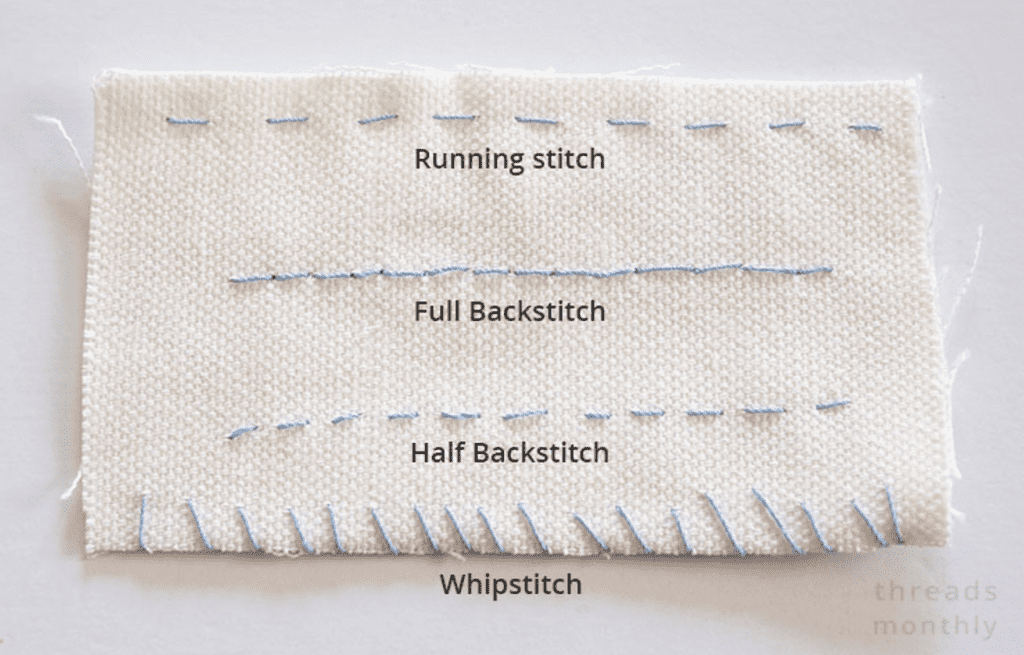
Front view of common hand-sewing stitches used to create seams. Photo credit: Alex Davies
Running Stitch
The running stitch is one of the most basic types of hand stitches and is used for gathering, mending, and tucking. Basting stitches are longer versions of the running stitch and can be useful when dealing with lightweight or heavyweight fabrics.
Backstitch
Backstitch is a practical stitch for building clothes, and catch stitch is used for finishing hems and tacking facing invisibly.
Slip stitch
Slip Stitch is ideal for hems and other finishes, and a blanket stitch.
Buttonhole stitch
A buttonhole stitch is used for sewing eyelets or buttonholes by hand.
To execute these stitches, bring the needle through the fabric from the wrong side of pieces of fabric, then make the required stitch and bring the thread back up.
For the backstitch, work from left to right, taking small stitches and inserting the needle at the end of the previous stitch.
Take tiny stitches on the hem and garment for catch stitch, keeping them loose and even. This will ensure you are keeping a straight line and even stitch length
Slip stitch is made by bringing the needle through the fold of the hem and picking up a thread of fabric.
Meanwhile the blanket stitch or buttonhole stitch is executed by wrapping the thread around the needle like a French knot and making closely spaced stitches.
Once you’ve become familiar with basic hand-sewing stitches, it’s important to also learn the most common machine stitches.
Types of stitches sewing: sewing machine
With a sewing machine, you can make stronger and more durable stitches, which is especially helpful when working with heavier fabrics or knit fabrics.
By following our guide to sewing machine techniques, you’ll be able to master these basic stitches and take on easy sewing projects like Potholders and tote bags.
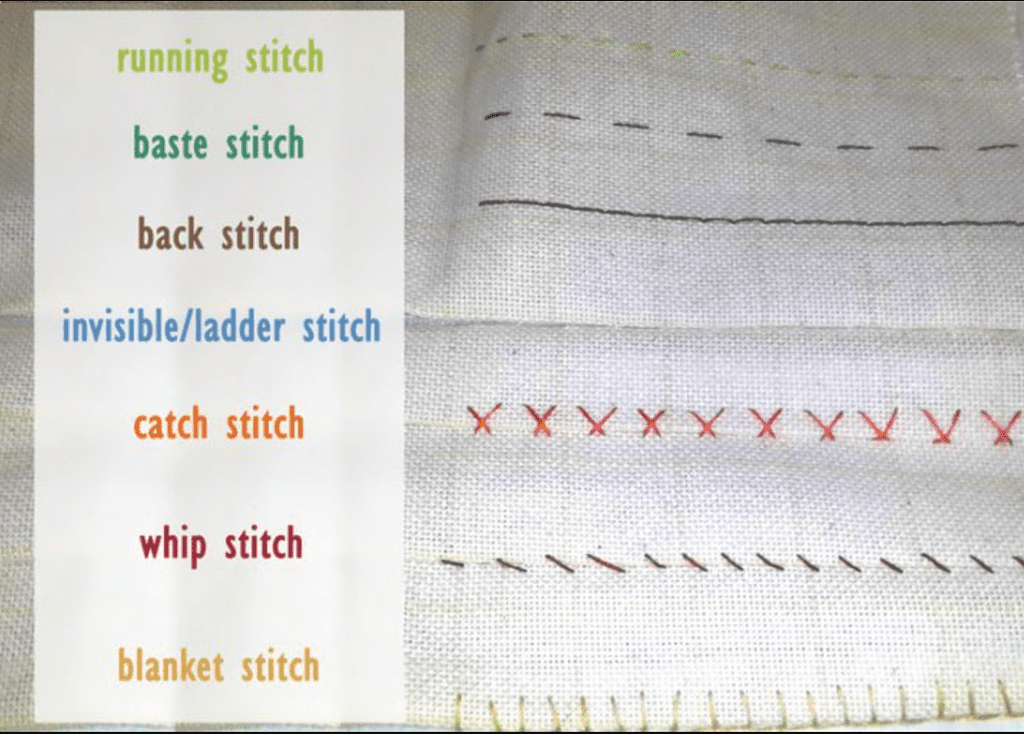
Photo courtesy of Wikipedia
Standard Forward/Backward Stitch
Start by straight stitching 1/8-3/8 inch from the edge of the fabric. Then, backstitch the forward stitch over the pinned or basted seam, and repeat the reverse stitch to finish. This type of stitch is great for seams, under stitching, stay stitching, and simple top stitching.
Zig-zag Stitch
This stitch type is perfect for finishing raw edges and can be combined with a stay stitching line for a clean finish. You can adjust the width and length of this stitch to suit your project’s needs.
For example, use this stitch to hem jeans with a sewing machine. These can also be fun decorative stitches, depending on your DIY project.
Buttonholes
Most sewing machines can create buttonholes with either a fully-automatic buttonhole foot attachment or a pre-programmed buttonhole.
The best way to learn this is to refer to your sewing machine manual for specific instructions.
Blind Hem Stitch
Consisting of two or three straight stitches followed by one wide zigzag/catch stitch, the blind hem stitch is similar to its hand-stitched counterpart.
Fold the fabric under and away, with the hem edge projecting, before using this stitch on your sewing machine.
Types of stitches sewing: Seam finishes
Once you have mastered the different types of sewing stitches, it’s time to move on to seam finishes.
Seam finishes are used to prevent fraying and ensure that the seam will withstand wear and tear. Before selecting a specific seam finish, you should consider the type of fabric, the desired strength and type of seam, and the appearance you want for the seam.
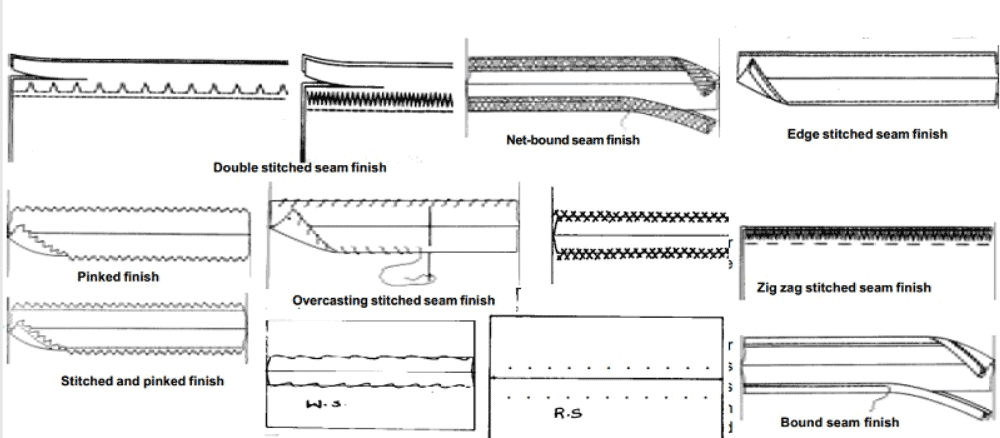
Photo courtesy of Brain Kart
Zigzag Finish
The zigzag finish is suitable for most types of fabric. After sewing and pressing open the seam towards the right side of the fabric, zigzag stitch the raw edge and trim off the excess.
The width and length of the zigzag stitch can be adjusted according to the fabric weight. Another option is to trim the seam edges to half their depth, zigzag them together, and press them to one side.
Turn and Stitch Finish
This finish is commonly used on crisp cotton fabrics. Fold and press the seam, leaving a 1/4 inch allowance, and machine stitch along the folded edge to finish.
The seams can be pressed open or to one side, depending on the pattern instructions. This finish provides a neat appearance and wears well.
Bias Tape Finish
Bias tape finish is typically used on unlined jackets and skirts. Use a purchased 5/8 inch bias tape to enclose the raw edge and stitch through all layers.
Commercial bias tape is usually slightly wider on one side, which should be placed underneath the fabric. Alternatively, you can create your own bias tape using a matching or contrasting fabric.
Pinked Seams
Pinked seams are the easiest of all seam finishes. Use pinking shears to trim the seam allowance as little as possible. This finish is best for wools and polyester fleece and is not very durable.
A better version of this finish involves machine stitching 1/4 inch from the seam and then trimming the edges with pinking shears.
Hand Overcast Finish
Hand overcast seam finish is used instead of a zigzag stitch on small areas or very thick fabrics. Use loose stitches to overcast the raw seam edges by hand.
Top Stitch Finish
The top stitch finish creates a hard hemline and can be used to strengthen or decorate the seam. Press the seams open and stitch in place from the wrong side.
The seams can be pinked beforehand, sometimes with a contrasting bobbin thread. This helps lightweight fabrics and stretch fabric pieces from fraying.
This is one of the most commonly used stitches and it’s a good idea to practice this on your regular sewing machine using stretchy fabrics, a piece of fabric like cotton or denim. This is the decorative stitching you see on most fabric edges.

